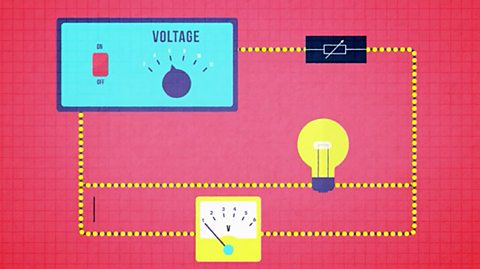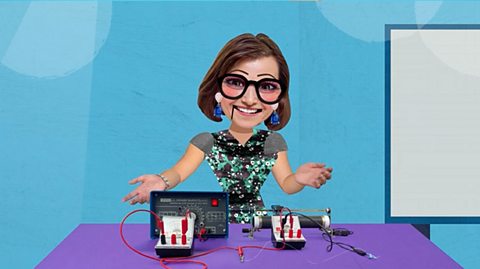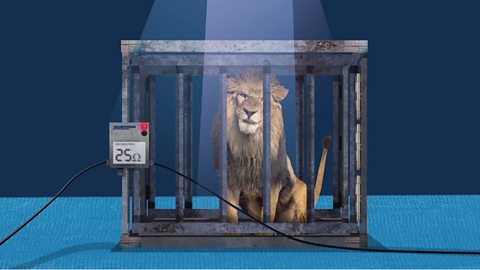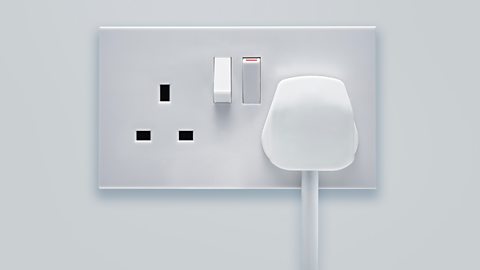What are the key learning points about conductors and insulators?
conductorAn electrical conductor is a material which allows an electrical current to pass through it easily. It has a low resistance. have free electronsNegatively charged sub-atomic particles that can move through the structure of a substance, usually a metal or graphite. A material with many free electrons is a good conductor. and insulatorMaterial that does not allow charge or heat to pass through it easily. do not.
Electric current in a metal is a flow of (free) electrons and the electrons move in the opposite direction to that of a conventional current.
What are electrical charges?
All matter consists of atomAll elements are made of atoms. An atom consists of a nucleus containing protons and neutrons, surrounded by electrons..
Atoms contain three types of smaller particles: protonSubatomic particle with a positive charge and a relative mass of 1. The relative charge of a proton is +1., neutronUncharged subatomic particle, with a relative mass of 1. The relative charge of a neutron is 0 (neutral). and electronA subatomic particle with relative mass of ¹⁄₁₈₄₀. The relative charge of an electron is -1..
Protons are positively charged.
Electrons are negatively charged.
Neutrons have no charge – they are neutral.
Protons and neutrons are found inside the nucleusThe central part of an atom. It contains protons and neutrons, and has most of the mass of the atom. The plural of nucleus is nuclei..
Electrons orbit the nucleus.
An atom has a neutral charge, because it contains the same number of positive protons and negative electrons.
If it loses an electron, it becomes a positively charged ion.
If it gains an electron, it becomes negatively charged ion.
Charged atoms are called ions.
An electric current is a flow of charged particles in one direction.
In solids, an electric current is the flow of free electronsNegatively charged sub-atomic particles that can move through the structure of a substance, usually a metal or graphite. A material with many free electrons is a good conductor. in one direction.
Key points:
An electric current is a flow of charged particles (free electrons) in one direction.
Metals are good conductors of electricity because they contain free electrons.
Insulators such as plastic and rubber do not contain free electrons and so are poor conductors of electricity.
| Good conductors | Insulators or poor conductors |
|---|---|
| Silver | Rubber |
| Copper | Plastic |
| Aluminium | Glass |
| Steel | Wood |
| Gold | Marble |
What are free electrons?
The particles in a metal are held together by strong metallic bonds.
The particles are close together and in a regular arrangement.
The atoms in metals have loosely bound electrons in the outer shellAn energy level around the nucleus where electrons can be found orbiting., which form a 'sea' of delocalised or free negative charge around the close-packed positive ionElectrically charged particle, formed when an atom gains or loses electrons..
These weakly held electrons are called free electrons.
They can move freely throughout the metallic structure.
An electric current is the flow of these free electrons in one direction.
What is cell polarity?
Every cell and battery has a positive (+) terminal and a negative (-) terminal.
The longer line is the positive (+) terminal.
The shorter line is the negative (-) terminal.
So, in the case of a cell:
In the case of a battery of two cells:
Notice that a battery symbol is made from joining cell symbols together.
Think of what we usually call a single battery, like the type you put in a TV remote control.
In physics, each of these is actually called a cell - it is only when you have two or more of these cells connected together that you call it a battery.
In circuit diagrams the positive side of a cell or battery is represented by the longer line and the negative side is represented by the shorter side.
This is referred to as the polarity of the cell.
Cells can be joined together minus-to-plus to make a battery.
Cells connected in this way are said to be connected in series.
Connecting cells in series to make a battery increases the voltage.
To calculate the total voltage of the battery, add together the individual voltages of the cells.
If the polarity of one of the cells is reversed, then the voltage is reduced.
Cells joined + to + (or - to -) cancel each other out.
How does an electric cell cause free electrons to flow?
Energy is required to make the free electrons travel in one direction.
An electric cell (often called a battery) can supply this energy and make free electrons move in a metal conductor connected between its two terminals.
Electrons flow from the negative terminal through the conductor to the positive terminal.
This is because electrons are negatively charged and so they are repelled from the negative terminal (like charges repel) and are attracted to the positive terminal (unlike charges attract).
What is the direction of conventional current?
Electric current was discovered before physicists knew about free electronsNegatively charged sub-atomic particles that can move through the structure of a substance, usually a metal or graphite. A material with many free electrons is a good conductor..
It was originally thought that the current was flowing in the opposite direction, i.e. from the positive terminal of the battery, through the conductor, to the negative terminal.
For a number of reasons, although this is now known to be the wrong direction, it is still the direction of current marked on all circuit diagrams.
It is called the direction of conventional current.
Key points
The direction of conventional current is from the positive terminal, through the conductor, to the negative terminal.
The direction of free electron flow is from the negative terminal, through the conductor, to the positive terminal.
The direction of conventional current is the direction marked on all circuit diagrams.
The symbol for electric current is I.
Test: Conventional current or free electron flow?
What are examples of simple circuits?
Series connections
Components that are connected one after another on the same loop of the circuit are connected in series.
Two lamps connected in series
The circuit diagram shows a circuit with two lamps connected in series. If one lamp breaks, the other lamp will not light.
Series circuits are useful if you want a warning that one of the components in the circuit has failed.
For example, a circuit breaker or fuse must be connected in series in order for it to work.
If Christmas tree lights are connected in series they all go out when one bulb breaks.
Parallel connections
Components that are connected on separate branches are connected in parallel.
The current is shared between each of the circuit branches.
The total amount of current flowing into the junction, or split, is equal to the total current flowing out.
The current is described as being conserved.
Two lamps connected in parallel
The circuit diagram shows a circuit with two lamps connected in parallel.
If one lamp breaks, the other lamp will still light.
The lights in most houses are connected in parallel.
This means that if one bulb breaks the others remain on.
For a parallel circuit, the sum of all the current in every branch is equal to the current from the electrical supply.
Key points
For components in series, the current is the same and if one component breaks then the other component will not work.
For components in parallel, the current is shared and if one component breaks then the other component will still work.
Question
Which of the circuits here are connected in series, and which are connected in parallel?
Answer
What are the standard electrical circuit symbols?
The following symbols show the different components that can be found in an electrical circuit.
Components
Some of the more common components are:
Switch
A switch is used to turn a circuit on (closed) and off (open).
When the switch is open, there is a break in the circuit and current stops flowing.
Lamp
An electric current heats the filament in a bulb so that it glows white hot and gives out light.
Fixed resistor
A resistor restricts or limits the flow of electrical current.
A fixed resistor has a resistance that does not change.
Variable resistor
Adjusting this resistor changes its resistance.
A variable resistor is used in some dimmer switches and volume controls.
Cell
A chemical reaction occurs inside a cell with chemical energy being converted to electrical energy.
A cell has a positive terminal and a negative terminal.
How much do you know about conductors and insulators?
More on Unit 2: Electricity
Find out more by working through a topic
- count2 of 5

- count3 of 5

- count4 of 5

- count5 of 5
